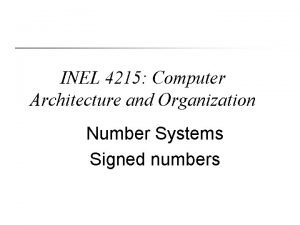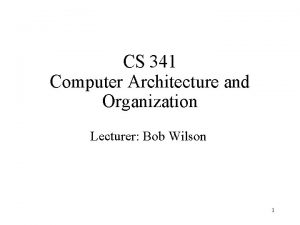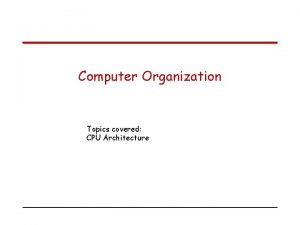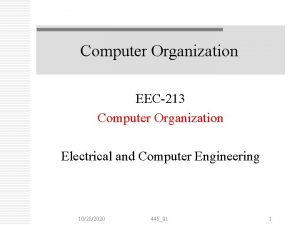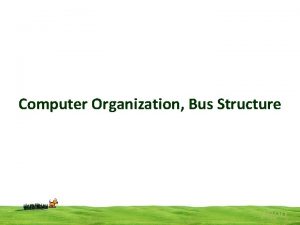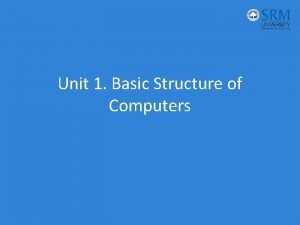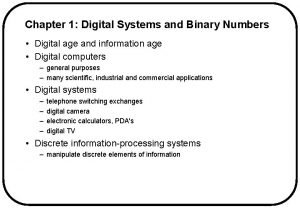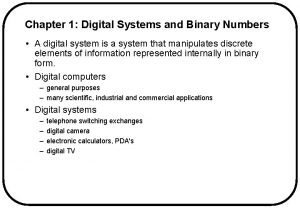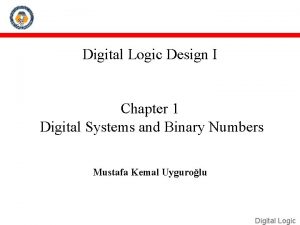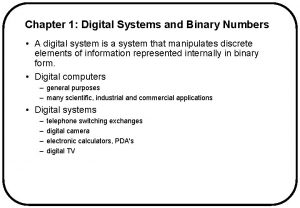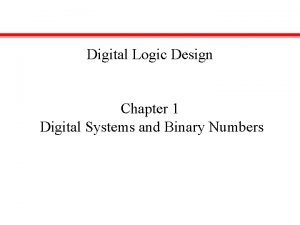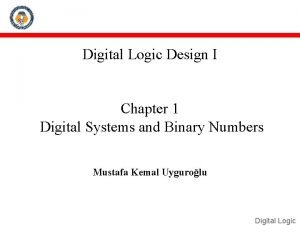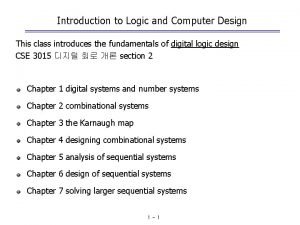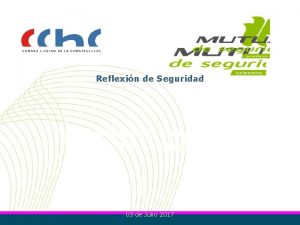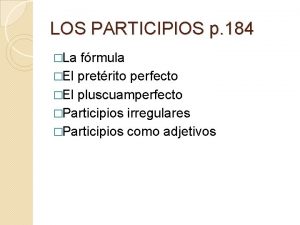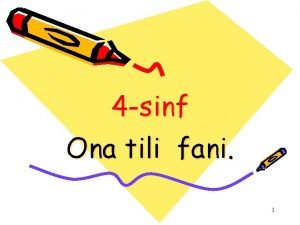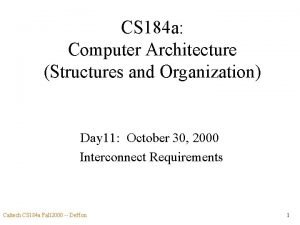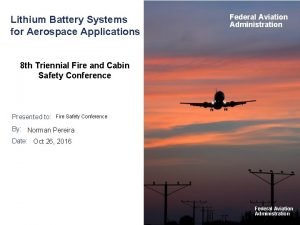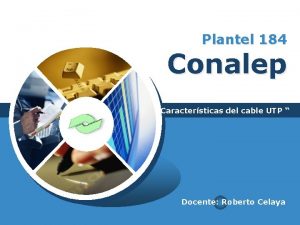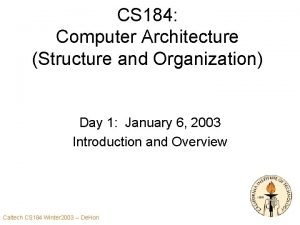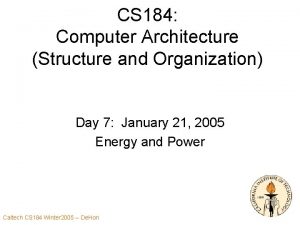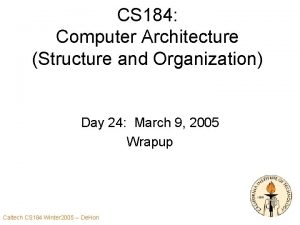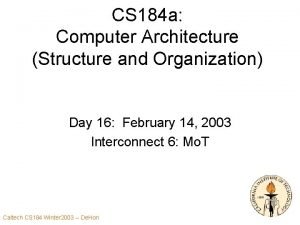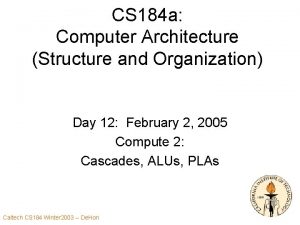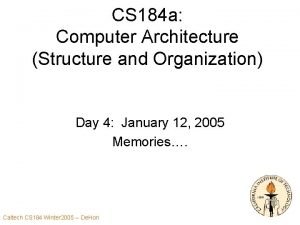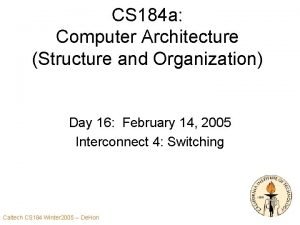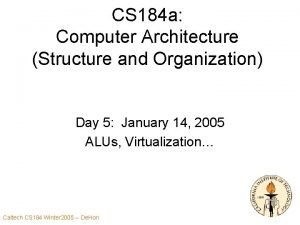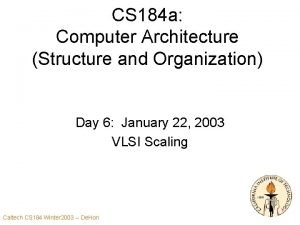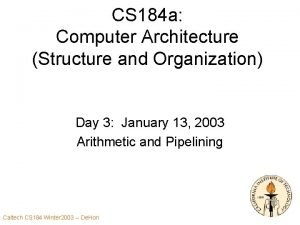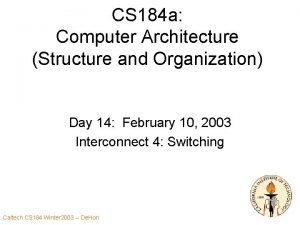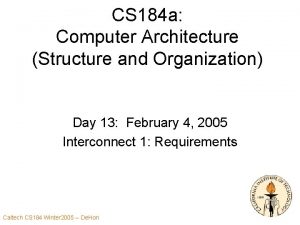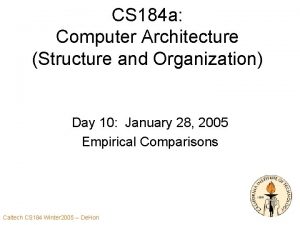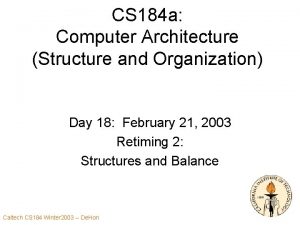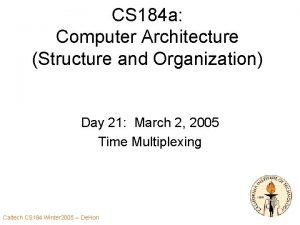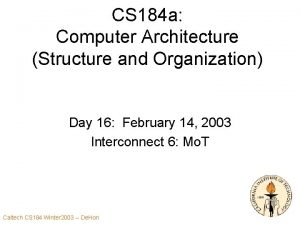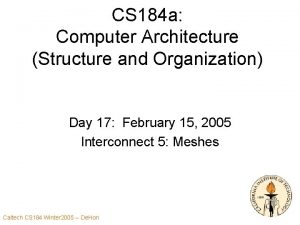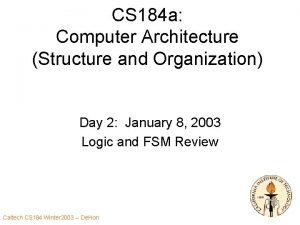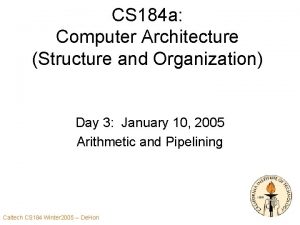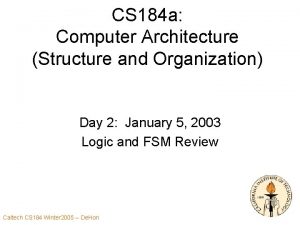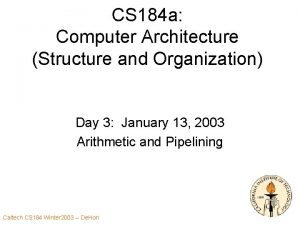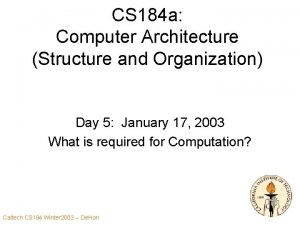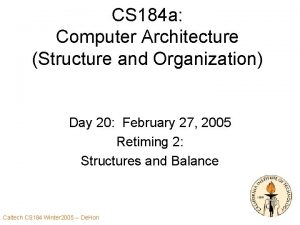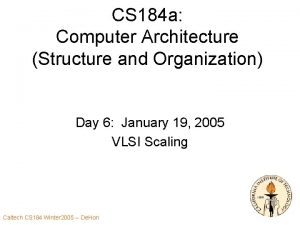CS 184 Computer Architecture Structure and Organization Day


























![What has changed? • [Discuss] • Capacity – Total – Per die • Size What has changed? • [Discuss] • Capacity – Total – Per die • Size](https://slidetodoc.com/presentation_image_h2/6e17b235d79125a01d464771f976520c/image-27.jpg)





![Class Components • Lecture • Reading [1 required paper/lecture] – No text • Weekly Class Components • Lecture • Reading [1 required paper/lecture] – No text • Weekly](https://slidetodoc.com/presentation_image_h2/6e17b235d79125a01d464771f976520c/image-33.jpg)







- Slides: 40

CS 184: Computer Architecture (Structure and Organization) Day 1: January 3, 2005 Introduction and Overview Caltech CS 184 Winter 2005 -- De. Hon

Today • • • Matter Computes Architecture Matters This Course (short) Unique Nature of This Course Relation to other courses More on this course Caltech CS 184 Winter 2005 -- De. Hon

Review: Two Universality Facts • Turing Machine is Universal – We can implement any computable function with a TM – We can build a single TM which can be programmed to implement any computable function • NAND gate Universality – We can implement any computation by interconnecting a sufficiently large network of NAND gates Caltech CS 184 Winter 2005 -- De. Hon

Review: Matter Computes • We can build NAND gates out of: – transistors (semicondutor devices) • physical laws of electron conduction – mechanical switches • basic physical mechanics – protein binding / promotion / inhibition • Basic biochemical reactions – …many other things Caltech CS 184 Winter 2005 -- De. Hon

Starting Point • Given sufficient raw materials: – can implement any computable function • Our goal in computer architecture – is not to figure out how to compute new things – rather, it is an engineering problem Caltech CS 184 Winter 2005 -- De. Hon

Engineering Problem • Implement a computation: – with least resources (in fixed resources) • with least cost – in least time (in fixed time) – with least energy • Optimization problem – how do we do it best? Caltech CS 184 Winter 2005 -- De. Hon

Quote • “An Engineer can do for a dime what everyone else can do for a dollar. ” Caltech CS 184 Winter 2005 -- De. Hon

Architecture Matters? • How much difference is there between architectures? • How badly can I be wrong in implementing/picking the wrong architecture? • How efficient is the IA-32, IA-64? – Is there much room to do better? • Is architecture done? – A solved problem? Caltech CS 184 Winter 2005 -- De. Hon

Peak Computational Densities from Model • Small slice of space – only 2 parameters • 100 density across • Large difference in peak densities – large design space! Caltech CS 184 Winter 2005 -- De. Hon

Yielded Efficiency FPGA (c=w=1) “Processor” (c=1024, w=64) • Large variation in yielded density – large design space! Caltech CS 184 Winter 2005 -- De. Hon

Architecture Not Done • Many ways, not fully understood – design space – requirements of computation – limits on requirements, density. . . • …and the costs are changing – optimal solutions change – creating new challenges and opportunities Caltech CS 184 Winter 2005 -- De. Hon

Personal Goal? • Develop systematic design • Parameterize design space – adapt to costs • Understand/capture req. of computing • Efficiency metrics – (similar to information theory? ) • …we’ll see a start at these this quarter Caltech CS 184 Winter 2005 -- De. Hon

Architecture Not Done • Not here to just teach you the forms which are already understood – (though, will do that and give you a strong understanding of their strengths and weaknesses) • Goal: enable you to design and synthesize new and better architectures Caltech CS 184 Winter 2005 -- De. Hon

This Course (short) • • • How to organize computations Requirements Design space Characteristics of computations Building blocks – compute, interconnect, retiming, instructions, control • Comparisons, limits, tradeoffs Caltech CS 184 Winter 2005 -- De. Hon

This Course • Sort out: – Custom, RISC, SIMD, Vector, VLIW, Multithreaded, Superscalar, EPIC, MIMD, FPGA • Basis for design and analysis • Techniques • [more detail at end] Caltech CS 184 Winter 2005 -- De. Hon

Graduate Class • Assume you are here to learn – Motivated – Mature – Not just doing minimal to get by and get a grade • Problems – May not be fully, tightly specified Caltech CS 184 Winter 2005 -- De. Hon

Uniqueness of Class Caltech CS 184 Winter 2005 -- De. Hon

Not a Traditional Arch. Class • Traditional class – focus RISC Processor – history – undergraduate class on u. P internals – then graduate class on details • This class – much broader in scope – develop design space – see RISC processors in context of alternatives Caltech CS 184 Winter 2005 -- De. Hon

Authority/History • ``Science is the belief in the ignorance of experts. '' -- Richard Feynman • Traditional Architecture has been too much about history and authority • Should be more about engineering evaluation – physical world is “final authority” • Goal: Teach you to think critically and independently about computer design. Caltech CS 184 Winter 2005 -- De. Hon

On Prerequisites • Suggested: – CS 21 (compute models, universality) – EE 4 (boolean logic, basic logic circuits) Caltech CS 184 Winter 2005 -- De. Hon

Next Few Lectures • Quick run through logic/arithmetic basics – make sure everyone remembers – (some see for first time? ) – get us ready to start with observations about the key components of computing devices • Trivial/old hat for many – But will be some observations couldn’t make in EE 4 • May be fast if seeing for first time • Background quiz intended to help me tune Caltech CS 184 Winter 2005 -- De. Hon

Relation to Other Courses • • CS 181 (VLSI) EE 4 (Fundamentals of Digital Systems) CS 184 (Architecture) CS 137 (Electronic Design Automation) CS 24 (Introduction to Computing Systems) CS 134 (Compilers and Systems) CS 21 (Computational Theory) Caltech CS 184 Winter 2005 -- De. Hon

Content Overview • This quarter: – building blocks and organization – raw components and their consequences • Next quarter: – abstractions, models, techniques, systems – will touch on conventional, single-threaded architecture (ISA Processor) – Emphasis likely to be on parallel architectures Caltech CS 184 Winter 2005 -- De. Hon

Themes (this quarter) • • • Design Space Parameterization Costs Change Structure in Computations Caltech CS 184 Winter 2005 -- De. Hon

This Quarter • Focus on raw computing organization • Not worry about – nice abstractions, models • Will come back to those next quarter Caltech CS 184 Winter 2005 -- De. Hon

Change • A key feature of the computer industry has been rapid and continual change. • We must be prepared to adapt. • For our substrate: – capacity (orders of magnitude more) • what can put on die, parallelism, need for interconnect and virtualization, homogeneity – speed – relative delay of interconnect and gates Caltech CS 184 Winter 2005 -- De. Hon
![What has changed Discuss Capacity Total Per die Size What has changed? • [Discuss] • Capacity – Total – Per die • Size](https://slidetodoc.com/presentation_image_h2/6e17b235d79125a01d464771f976520c/image-27.jpg)
What has changed? • [Discuss] • Capacity – Total – Per die • Size • Applications – Number – Size/complexity of each – Types/variety Caltech CS 184 Winter 2005 -- De. Hon • Speed – Ratio of fast memory to dense memory – Wire delay vs. Gate delay – Onchip vs. inter-chip • Joules/op • Mfg cost – Per transistor – Per wafer

1983 (early VLSI) • Early RISC processors – RISC-II, 15 Ml 2, 40 K transistors – MIPS, 20 Ml 2, 24 K transistors – ~10 MHz clock cycle • Xilinx XC 2064 – 64 4 -LUTs Caltech CS 184 Winter 2005 -- De. Hon

Today • CPUs – Multi-issue, 64 b processors – GHz clock cycles – MByte caches • FPGAs – >100, 000 bit processing elements – Mbits of on-chip RAM Caltech CS 184 Winter 2005 -- De. Hon

More chip capacity? • Should a 2005 single-chip multiprocessor look like a 1983 multiprocessor systems? – Processor processor latency? – Inter-processor bandwidth costs? – Cost of customization? Caltech CS 184 Winter 2005 -- De. Hon

Memory Levels • Why do we have 5+ levels of memory today? – Apple II, IBM PC had 2 – MIPS-X had 3 Caltech CS 184 Winter 2005 -- De. Hon

Class Components Caltech CS 184 Winter 2005 -- De. Hon
![Class Components Lecture Reading 1 required paperlecture No text Weekly Class Components • Lecture • Reading [1 required paper/lecture] – No text • Weekly](https://slidetodoc.com/presentation_image_h2/6e17b235d79125a01d464771f976520c/image-33.jpg)
Class Components • Lecture • Reading [1 required paper/lecture] – No text • Weekly assignments • Final design/analysis exercise – (2 weeks) Caltech CS 184 Winter 2005 -- De. Hon

Lecture Schedule • Scheduled MWF 1. 5 hrs • To allow for lost days – Holidays – Conferences • Target use 22 of ideally 30 lectures • (standard MW would ideally have 20) Caltech CS 184 Winter 2005 -- De. Hon

Feedback • Will have anonymous feedback sheets for each lecture – Clarity? – Speed? – Vocabulary? – General comments Caltech CS 184 Winter 2005 -- De. Hon

Fountainhead Quote Howard Roark’s Critique of the Parthenon -- Ayn Rand Caltech CS 184 Winter 2005 -- De. Hon

Fountainhead Parthenon Quote “Look, ” said Roark. “The famous flutings on the famous columns---what are they there for? To hide the joints in wood---when columns were made of wood, only these aren’t, they’re marble. The triglyphs, what are they? Wooden beams, the way they had to be laid when people began to build wooden shacks. Your Greeks took marble and they made copies of their wooden structures out of it, because others had done it that way. Then your masters of the Renaissance came along and made copies in plaster of copies in marble of copies in wood. Now here we are making copies in steel and concrete of copies in plaster of copies in marble of copies in wood. Why? ” Caltech CS 184 Winter 2005 -- De. Hon

Caltech CS 184 Winter 2005 -- De. Hon

Computer Architecture Parallel • Are we making: – copies in submicron CMOS – of copies in early NMOS – of copies in discrete TTL – of vacuum tube computers? Caltech CS 184 Winter 2005 -- De. Hon

Big Ideas • Matter Computes • Efficiency of architectures varies widely • Computation design is an engineering discipline • Costs change Best solutions (architectures) change • Learn to cut through hype – analyze, think, critique, synthesize Caltech CS 184 Winter 2005 -- De. Hon
 Day 1 day 2 day 3 day 4
Day 1 day 2 day 3 day 4 Difference between organization and architecture
Difference between organization and architecture Basic structure of a computer system
Basic structure of a computer system Day 1 day 2 day 817
Day 1 day 2 day 817 Computer organization and architecture 10th solution
Computer organization and architecture 10th solution Iit kharagpur virtual lab coa
Iit kharagpur virtual lab coa Introduction to computer organization and architecture
Introduction to computer organization and architecture Spec rating formula in computer organization
Spec rating formula in computer organization Computer organization and architecture 10th edition
Computer organization and architecture 10th edition Computer organization and architecture william stallings
Computer organization and architecture william stallings Computer organization and architecture definition
Computer organization and architecture definition 1s complement
1s complement Cs341 umb
Cs341 umb Process organization in computer organization
Process organization in computer organization Three bus architecture
Three bus architecture Instruction set architecture in computer organization
Instruction set architecture in computer organization Memory organization in computer architecture
Memory organization in computer architecture Design of basic computer
Design of basic computer Simple computer design
Simple computer design Single bus structure in computer organization
Single bus structure in computer organization Single bus structure in computer organization
Single bus structure in computer organization Single bus structure in computer organization
Single bus structure in computer organization Basic structure of a computer
Basic structure of a computer Bcd addition of 184 and 576
Bcd addition of 184 and 576 Rh nomenclature
Rh nomenclature Binary 1000
Binary 1000 Bcd addition of 184 and 576
Bcd addition of 184 and 576 Bcd addition of 184 and 576
Bcd addition of 184 and 576 Bcd addition of 184 and 576
Bcd addition of 184 and 576 1 x 1010100
1 x 1010100 Bcd addition of 184 and 576
Bcd addition of 184 and 576 Compare and contrast organization
Compare and contrast organization Artículo 184
Artículo 184 184/1 tck
184/1 tck Signing naturally homework 4:1
Signing naturally homework 4:1 4 sinf ona tili 33 mashq
4 sinf ona tili 33 mashq 4 184 joules
4 184 joules Cs 184
Cs 184 Cs 184
Cs 184 Rtca do-227
Rtca do-227 Conalep coacalco
Conalep coacalco











